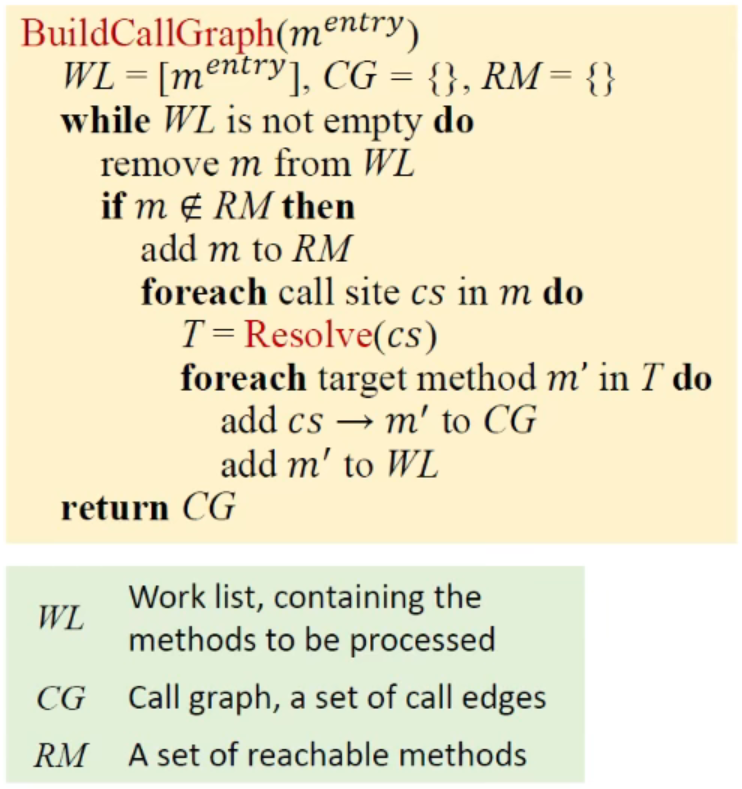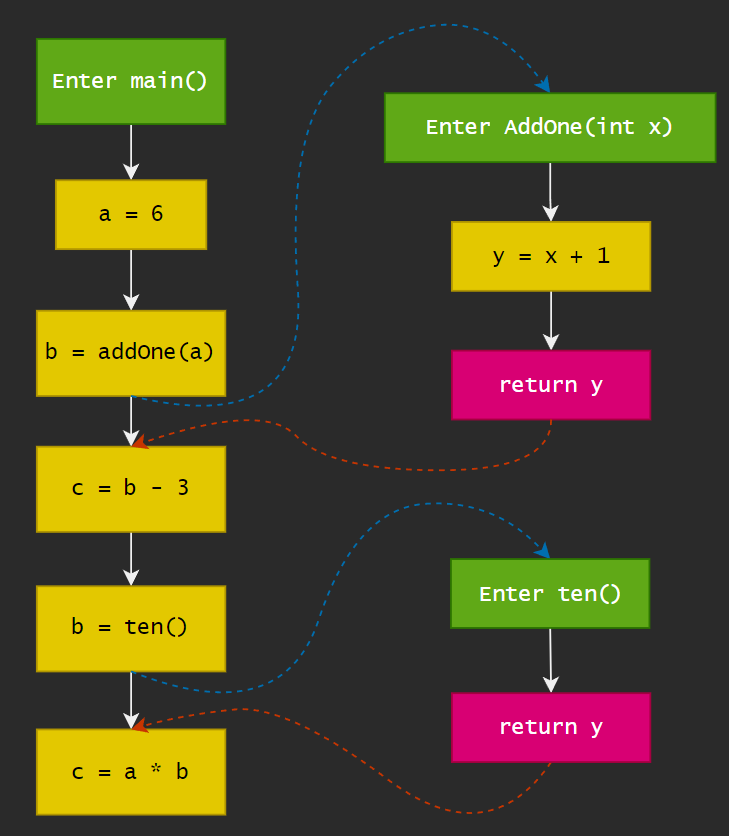static_program_analysis_05_interprocedural_analysis
Interprocedural Analysis
Contents
- Motivation
- Call Graph Construction (CHA)
- Interprocedural Control-Flow Graph
- Interprocedural Data-Flow Analysis
Motivation
Problem of Intraprocedural Analysis
过程内分析,要如何分析函数调用?
-
最保守的假设:在常量传播检测(constant propagation)中,需要假设未知的变量不是常量,因此丢失了精度。
void foo(){
int n = ten();
addOne(42);
}
int ten(){
return 10;
}
int addOne(int x){
int y = x + 1;
return y;
}
int main(){
foo()
}对于foo()函数而言,结果应该是n=10,由于函数内的分析无法判断ten()返回的值是什么,一次你只能保守假设ten()返回了非常量的值。
因此需要过程间分析(interprocedural Analysis),通过Graph中的边传递data flow,因此避免了过度假设导致的精度丢失。而call graph包含了点和有向边。
Call Graph
A representation of calling relationships in the program. Essentially, a call graph is a set of call edges from call-sites to their target methods.(callees)
以上面的函数调用为例子,有如下调用图:

调用图call graph在很多分析中都有所应用。
Call Graph Construction for OOPLs
focus on JAVA
构造调用图的方法有:
-
Class hierarchy analysis (CHA)
-
Rapid type analysis (RTA)
-
Variable type analysis (VTA)
-
Pointer analysis (k-CFA)
以上的方法中,从上到下所得到的精度越高,但是效率有所降低。
在Java中有如下三种方法调用:
| Statck call | Special call | Virtual call | |
|---|---|---|---|
| Instruction | invokestatic | invokespecial | 1) invokeinterface 2) invokevirtual |
| Receiver objects | × | √ | √ |
| Target methods | Static methods | 1) Constructors 2) Private instance methods 3) Superclass instance methods |
Other instance methods |
| Number of Target methods | 1 | 1 | >=1(polymorphism) |
| Determinacy | Compile-time | Compile-time | Run-time |
构造调用图的关键在于处理Virtual call;
Method Dispatch of Virutal call
During run-time, a virtual call is resolved based on:
$$
o1.foo(…)2;
$$
-
type of the receiver object(pointed by o)
-
method signature at the call site
如上,在程序运行时,virtual call需要对调用的实例方法进行resolve,这个过程设计到以上两个要素:
- o指向的具体类型 c;
- 调用时的方法签名 m;
对于签名signature:
- Signature = class type + method name + descriptor
- Descriptor = return type + paramter types
即,对于下面的方法foo()而言:
class C{ |
有如下的签名:<C: T foo(P,Q,R)>,定义缩写为:C.foo(P,Q,R)
由此可以定义一个函数Dispatch(c, m),模拟动态时dispatch method的过程;

当c所包含的非抽象方法m’和m有相同的名字和描述时,即返回对应的m’,相当于知道了对应的method。否则,递归其父类,寻找符合条件的m’。
Sample
有以下例子:
class A { |
那么对于A x = new B(); x.foo();,Dispatch(B, A.foo())对应哪一个方法呢?
- 首先Dispatch会先查找B类中的foo()方法,但是B类中并没有声明任何方法;
- 因此会到A类中寻找foo()方法,得到
Dispatch(B, A.foo())=A.foo();
那么对于A y = new C(); y.foo();,Dispatch(C, A.foo())对应哪一个方法呢?
- 首先Dispatch会先查找C中的foo()方法,因为C中存在了foo()的声明,并且signature一致,因此对应的方法是
C.foo();
1-Class Hierarchy Analysis *(CHA)
-
Require the class hierarchy information(inheritance structure) of the whole program - 需要程序中类的继承关系
-
Resolve a virtual call based on the declared type of receiver variable of the call site - 需要根据声明类型resolve virtual call
A a = ...
a.foo() -
Assume the receiver variable a may point to objects of class A or all subclasses of A - 查询A类的继承结构来找目标方法
- Resolve target methods by looking up the class hierarchy of class A
call resolution of CHA
We define function Resolve(cs) to resolve possible target methods of a call site cs by CHA - 定义一种Resolve(cs)方法,来resolve可能被调用的目标函数。

-
首先初始化变量T;
-
用变量m存放call site对应方法的签名
-
对三种调用情况进行分别处理:
-
对于static call,将签名直接存放到T中;
对于:
class C{
static T foo(P p, Q q){
...
}
}
C.foo(x, y);可以得到:
cs: C.foo(x, y)
m: <C: T foo(P,Q)> -
对于special call
-
对于处理Superclass instance method,有以下例子:
class C extends B {
static T foo(P p, Q q){
...
super.foo(p, q);
}
}可以得到:
cs: super.foo(p, q);
m: <B: T foo(P,Q)>
c^m: B
T = {Dispatch(c^m, m)} = {Dispatch(B, m)}这里还要做Dispatch是因为不知道B中是否含有对应的方法,也许B也是集成自另一个类的对应方法foo();
-
对于处理Private instance method或是Constructor,有以下例子:
class C extends B {
T foo(P p, Q q){
...
this.bar();
}
private T bar();
}
C c = new C();
-
-
对于virtual call
-
对于以下例子:
class C {
T foo(P p, Q q){
...
}
}
C c = ...
c.foo(x, y)可以得到:
cs: c.foo(x, y)
m: <C: T foo(P, Q)>
c: C对应算法的处理,对当前类c以及每一个c的子类c’进行dispatch,保存结果到T;
-
-
Sample
存在以下程序:
class A { |
其继承关系如图:

有:
- Resolve(c.foo()) = {C.foo()} => 对当前类及其子类进行Dispatch => 没有子类,当前类包含target method => C.foo()
- Resolve(a.foo()) = {A.foo(), C.foo(), D.foo()} => 对当前类及其子类进行Dispatch => 当前类包含foo() => 子类C、D包含foo()
- Resolve(b.foo()) = {A.foo(), C.foo(), D.foo()} => 对当前类及其子类进行Dispatch => 当前类未包含,Dispatch到A => A包含foo() => 子类C、D包含foo()
若最后对b的声明中,B b = new B(); b.foo();。那么有:
Resolve(b.foo()) = {A.foo(), C.foo(), D.foo()}
根据算法,CHA中对于virtual call的处理,c只受声明类型的影响,这里虽然new B(),但本质类型还是B;
Features of CHA
- Fast
- 只考虑声明类型以及继承关系
- 忽略数据流、控制流信息
- imprecise
- 简单的函数关系处理
CHA在IDE中有所应用;
Call Graph Construction
via CHA
- start from graph for whole program via CHA
- For each reachable method m, resolve target methods for each call site cs in m via CHA
- Repeat until no new method is discovered
Algorithm

构建调用图的过程如上;
-
首先进行初始化,三个数据结构:
WL即为worklist,其中存储了需要进行处理的方法。初始化为入口方法$m^entry$;CG为调用边的集合;RM为reachable method,表示算法目前分析到的方法; -
随机是一个while循环,不断从worklist中取出方法并处理,过程中也许会加入新的方法;在循环内部,从worklist中取出一个方法,判断是否分析到,如果分析过了,这次循环就跳过,如果没有分析过,则为新的方法,需要进行处理;
-
对新方法的处理,先加入到
RM中,将该方法中所有的call site,对每一个call site进行resolve,得到的目标方法结果放在T中; -
对T中的每一个目标方法,将call site到目标方法的边加入到CG中,再将发现的目标方法加入到worklist中,其中有可能存在未分析过的方法;
-
只要worklist非空,循环会一直进行;
-
当worklist为空,则返回了调用边的集合;
Sample
存在以下例子;
class A{ |
对于上述代码,进行CHA算法,则有:
-
初始化,将入口方法
A.main()存放到worklist中Worklist Call Graph Reachable Method [A.main()] {} {} -
判断该方法
A.main()是否在Reachable Method中,如果不存在,则将方法A.main()从Worklist中取出,并将该方法放入Reachable Method中;Worklist Call Graph Reachable Method [] {} {A.main()} -
解出该方法中的每一个cs,当前cs只有一个,为
Resolve(A.foo()),因为A.foo()为静态方法static void foo(),因此得到target method;Resolve(A.foo())={A.foo()}
T = {A.foo()} -
对于T中的每一个
target method,添加cs到target method的边到Call Graph中,并将target method,即A.foo()添加到Worklist中;Worklist Call Graph Reachable Method [A.foo()] 
{A.main()} -
此时判断Worklist是否为空,不为空则继续resolve;
Worklist Call Graph Reachable Method [A.foo()] 
{A.main()} -
判断该方法
A.foo()是否在Reachable Method中,如果不存在,则将方法A.foo()从Worklist中取出,并将该方法放入Reachable Method中;Worklist Call Graph Reachable Method [] 
{A.main(), A.foo()} -
解出该方法中的每一个cs,当前cs只有一个,为
Resolve(a.bar())。因为A a = new A(),相当于调用了类A的构造函数,resolve后根据dispatch的规则,将得到其子类的同签名target method,得到的target method放到T中;Resolve(a.bar())={A.bar(), B.bar(), C.bar()}
T = {A.bar(), B.bar(), C.bar()} -
对于T中的每一个
target method,添加cs到target method的边到Call Graph中,并将target method添加到Worklist中;Worklist Call Graph Reachable Method [A.bar(), B.bar(), C.bar()] 
{A.main(), A.foo()} -
此时判断Worklist是否为空,不为空则继续resolve;
-
取出
A.bar(),判断RM中是否存在,不存在则枚举其所有的cs,得到c.bar(),对其进行Resolve(c.bar()),得到C.bar();Resolve(c.bar())={C.bar()}
T = {C.bar()} -
对于T中的每一个
target method,添加cs到target method的边到Call Graph中,并将target method添加到Worklist中;Worklist Call Graph Reachable Method [B.bar(), C.bar()] 
{A.main(), A.foo(), A.bar()} -
同理,对
B.bar()中的cs进行resolve,由于B.bar()为空函数,则得到的target Method也为空,因此没有指向新的Method;Worklist Call Graph Reachable Method [C.bar()] 
{A.main(), A.foo(), A.bar(), B.bar()} -
同理,对
C.bar()中的cs进行resolve,resolve(A.foo())={A.foo()},得到:Worklist Call Graph Reachable Method [] 
{A.main(), A.foo(), A.bar(), B.bar(), C.bar()} -
最后worklist已经为空,算法结束;
Interprocedural Control-Flow Graph
过程间控制流图
-
CFG represents structure of an individual method - CFG表示单个方法的结构
-
ICFG represents structure of the whole program - ICFG表示整个程序的结构
- with ICFG, we can perform interprocedural analysis - 因此可以做过程间分析
-
An ICFG of a program consists of CFGs of the methods in the program, plus two kinds of additional edges:
-
Call edges: from call sites to the entry nodes of their callees - 调用点到目标方法的
-
Return edges: from return statements of the callees to the statements following their call sites(i.e., return sites) - 目标方法的return语句到调用方法cs

例如:
// call site 的 return statement 会指向 return site
void foo(){
bar(...); // call site
int n = 3; // return site
} -
Sample
static void main(){ |
ICFG = CFGs + call & return edges |

上图中,蓝色箭头为Call edges,红色为return edges,黑色为CFG edges;
Interprocedural Data-Flow Analysis
利用上面的ICFG即可进行过程间数据流分析;
Analyzing the whole program with method calls based on interprocedural control-flow graph (ICFG)
| Intraprocedural | Interprocedural | |
|---|---|---|
| Program representation | CFG | ICFG = CFG + Call edges + Return Edges |
| Transfer functions | Node transfer - 通过结点转换 | Node transfer + edge transfer - 通过结点和边转换 |
关于 Edge transfer
- Call edge transfer: transfer data flow from call node to the entry node of callee(along call edges)
- Return edge transfer: transfer data flow from return node of the callee to the return site(along return edges)
Sample-Interprocedural Constant Propagation
以过程间常量传播为例子;
- Call edge transfer: pass argument values - 传参
- Return edge transfer: pass return values - 传返回值
- Node transfer: same as intra-procedural constant propagation, plus that - 与过程内分析时一致,但多了处理方法调用
- For each call node, kill data-flow value for the LHS variable. Its value will flow to return site along the return edges.
依旧使用上面的程序作为例子;
static void main(){ |
可以得到如下流程图:

在过程间分析后,得到的结果为:

最后得到的结果是:a = 6, b = 10, c = 60
而如果是过程内分析,由于缺少 call edges 和 return edges ,只能够保守假设,得到的结果是:a = 6, b = NAC, c = NAC
可见,在使用过程间分析后,在Constant Propagation中能够得到更好的精度;
Key point
- How to build call graph via CHA
- Concept of interprocedural control-flow graph
- Concept of interprocedural data-flow analysis
- Interprocedural constant propagation
